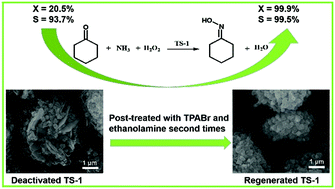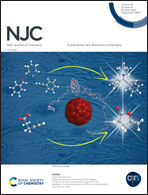Improved Ti species distribution and hierarchical pores in TS-1: towards regeneration of TS-1 deactivated due to alkali corrosion†
Abstract
An effective strategy to regenerate titanium silicalite-1 (TS-1) zeolite deactivated in the industrial cyclohexanone ammoximation process has been explored using tetrapropylammonium bromide (TPABr) and ethanolamine solution under hydrothermal conditions. With deactivated TS-1, the yield of cyclohexanone oxime was only 19.2% in the cyclohexanone ammoximation reaction. After the second regeneration, the regenerated TS-1 showed higher catalytic performance than fresh TS-1 and the yield of cyclohexanone oxime was up to 99.4%. Characterization results showed that the relative crystallinity, micropore surface, micropore volume, and surface framework Ti species were significantly restored and huge hierarchical pores were introduced after regeneration. Moreover, the regenerated TS-1 exhibited excellent performance than fresh TS-1 in resisting corrosion by alkali. The exploration of an effective strategy for regeneration of deactivated TS-1 can bring about economic and environmental benefits in the commercial ammoximation process, and provide new perspectives for developing more robust TS-1.



 Please wait while we load your content...
Please wait while we load your content...